Nitin Jonathan Myers
An Energy-efficient Ordered Transmission-based Sequential Estimation
Apr 15, 2025Abstract:Estimation problems in wireless sensor networks typically involve gathering and processing data from distributed sensors to infer the state of an environment at the fusion center. However, not all measurements contribute significantly to improving estimation accuracy. The ordered transmission protocol, a promising approach for enhancing energy efficiency in wireless networks, allows for the selection of measurements from different sensors to ensure the desired estimation quality. In this work, we use the idea of ordered transmission to reduce the number of transmissions required for sequential estimation within a network, thereby achieving energy-efficient estimation. We derive a new stopping rule that minimizes the number of transmissions while maintaining estimation accuracy similar to general sequential estimation with unordered transmissions. Moreover, we derive the expected number of transmissions required for both general sequential estimation with unordered transmissions and proposed sequential estimation with ordered transmissions and make a comparison between the two systems. Simulation results indicate that our proposed scheme can efficiently reduce transmissions while still ensuring the quality of estimation.
Hybrid Human-Machine Perception via Adaptive LiDAR for Advanced Driver Assistance Systems
Feb 24, 2025


Abstract:Accurate environmental perception is critical for advanced driver assistance systems (ADAS). Light detection and ranging (LiDAR) systems play a crucial role in ADAS; they can reliably detect obstacles and help ensure traffic safety. Existing research on LiDAR sensing has demonstrated that adapting the LiDAR's resolution and range based on environmental characteristics can improve machine perception. However, current adaptive LiDAR approaches for ADAS have not explored the possibility of combining the perception abilities of the vehicle and the human driver, which can potentially further enhance the detection performance. In this paper, we propose a novel system that adapts LiDAR characteristics to human driver's visual perception to enhance LiDAR sensing outside human's field of view. We develop a proof-of-concept prototype of the system in the virtual environment CARLA. Our system integrates real-time data on the driver's gaze to identify regions in the environment that the driver is monitoring. This allows the system to optimize LiDAR resources by dynamically increasing the LiDAR's range and resolution in peripheral areas that the driver may not be attending to. Our simulations show that this gaze-aware LiDAR enhances detection performance compared to a baseline standalone LiDAR, particularly in challenging environmental conditions like fog. Our hybrid human-machine sensing approach potentially offers improved safety and situational awareness in real-time driving scenarios for ADAS applications.
A divide-and-conquer approach for sparse recovery of high dimensional signals
Mar 07, 2024Abstract:Compressed sensing (CS) techniques demand significant storage and computational resources, when recovering high-dimensional sparse signals. Block CS (BCS), a special class of CS, addresses both the storage and complexity issues by partitioning the sparse recovery problem into several sub-problems. In this paper, we derive a Welch bound-based guarantee on the reconstruction error with BCS. Our guarantee reveals that the reconstruction quality with BCS monotonically reduces with an increasing number of partitions. To alleviate this performance loss, we propose a sparse recovery technique that exploits correlation across the partitions of the sparse signal. Our method outperforms BCS in the moderate SNR regime, for a modest increase in the storage and computational complexities.
Sparse Millimeter Wave Channel Estimation From Partially Coherent Measurements
Oct 11, 2023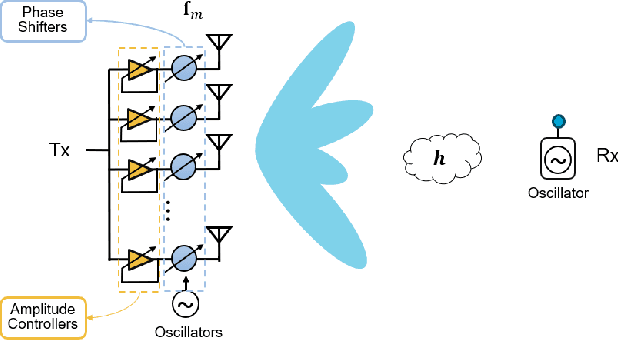
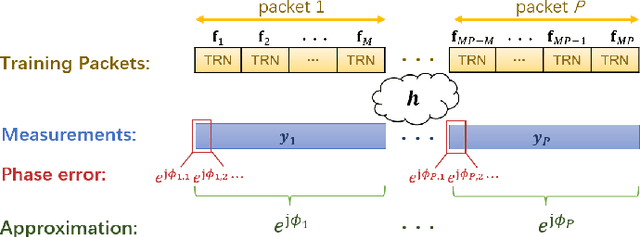
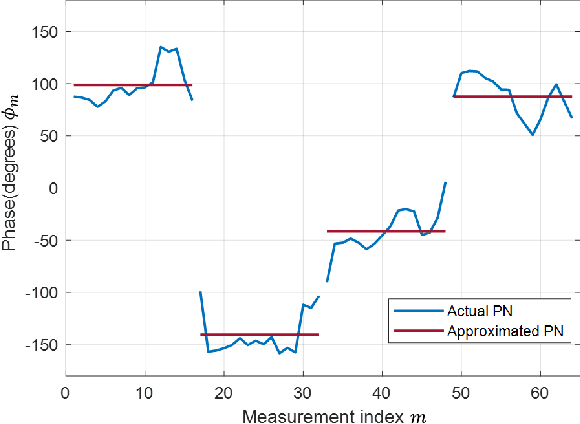

Abstract:This paper develops a channel estimation technique for millimeter wave (mmWave) communication systems. Our method exploits the sparse structure in mmWave channels for low training overhead and accounts for the phase errors in the channel measurements due to phase noise at the oscillator. Specifically, in IEEE 802.11ad/ay-based mmWave systems, the phase errors within a beam refinement protocol packet are almost the same, while the errors across different packets are substantially different. Consequently, standard sparsity-aware algorithms, which ignore phase errors, fail when channel measurements are acquired over multiple beam refinement protocol packets. We present a novel algorithm called partially coherent matching pursuit for sparse channel estimation under practical phase noise perturbations. Our method iteratively detects the support of sparse signal and employs alternating minimization to jointly estimate the signal and the phase errors. We numerically show that our algorithm can reconstruct the channel accurately at a lower complexity than the benchmarks.
In-sector Compressive Beam Alignment for MmWave and THz Radios
Aug 25, 2023



Abstract:Beam alignment is key in enabling millimeter wave and terahertz radios to achieve their capacity. Due to the use of large arrays in these systems, the common exhaustive beam scanning results in a substantial training overhead. Prior work has addressed this issue, by developing compressive sensing (CS)-based methods which exploit channel sparsity to achieve faster beam alignment. Unfortunately, standard CS techniques employ wide beams and suffer from a low signal-to-noise ratio (SNR) in the channel measurements. To solve this challenge, we develop an IEEE 802.11ad/ay compatible technique that takes an in-sector approach for CS. In our method, the angle domain channel is partitioned into several sectors, and the channel within the best sector is estimated for beam alignment. The essence of our framework lies in the construction of a low-resolution beam codebook to identify the best sector and in the design of the CS matrix for in-sector channel estimation. Our beam codebook illuminates distinct non-overlapping sectors and can be realized with low-resolution phased arrays. We show that the proposed codebook results in a higher received SNR than the state-of-the-art sector sweep codebooks. Furthermore, our optimized CS matrix achieves a better in-sector channel reconstruction than comparable benchmarks.
Analysis of Orthogonal Matching Pursuit for Compressed Sensing in Practical Settings
Mar 02, 2023Abstract:Orthogonal matching pursuit (OMP) is a widely used greedy algorithm for sparse signal recovery in compressed sensing (CS). Prior work on OMP, however, has only provided reconstruction guarantees under the assumption that the columns of the CS matrix have equal norms, which is unrealistic in many practical CS applications due to hardware constraints. In this paper, we derive sparse recovery guarantees with OMP, when the CS matrix has unequal column norms. Finally, we show that CS matrices whose column norms are comparable achieve tight guarantees for the successful recovery of the support of a sparse signal and a low mean squared error in the estimate.
Structured Sensing Matrix Design for In-sector Compressed mmWave Channel Estimation
May 23, 2022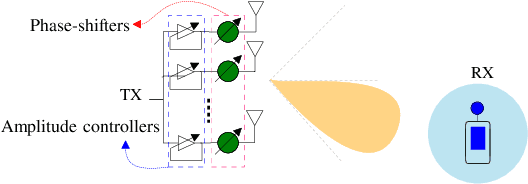
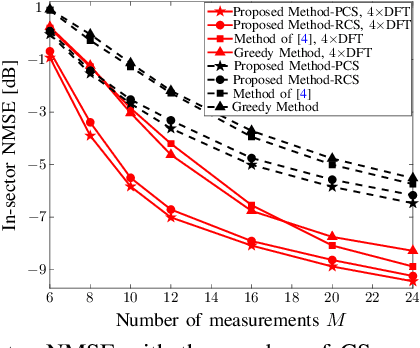
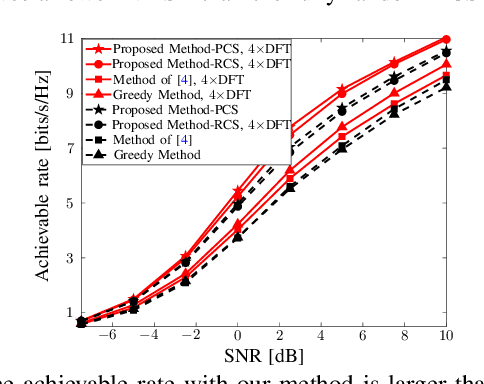
Abstract:Fast millimeter wave (mmWave) channel estimation techniques based on compressed sensing (CS) suffer from low signal-to-noise ratio (SNR) in the channel measurements, due to the use of wide beams. To address this problem, we develop an in-sector CS-based mmWave channel estimation technique that focuses energy on a sector in the angle domain. Specifically, we construct a new class of structured CS matrices to estimate the channel within the sector of interest. To this end, we first determine an optimal sampling pattern when the number of measurements is equal to the sector dimension and then use its subsampled version in the sub-Nyquist regime. Our approach results in low aliasing artifacts in the sector of interest and better channel estimates than benchmark algorithms.
Near-field focusing using phased arrays with dynamic polarization control
May 20, 2022

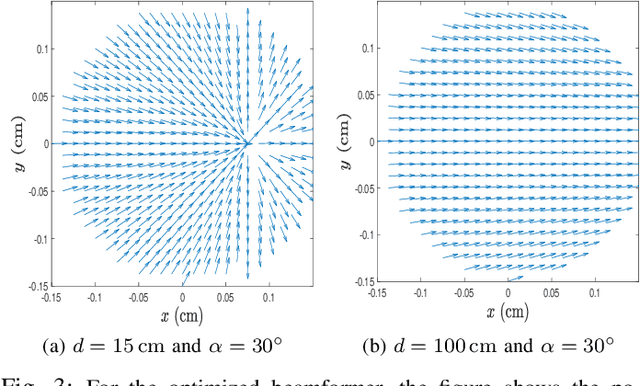

Abstract:Phased arrays in near-field communication allow the transmitter to focus wireless signals in a small region around the receiver. Proper focusing is achieved by carefully tuning the phase shifts and the polarization of the signals transmitted from the phased array. In this paper, we study the impact of polarization on near-field focusing and investigate the use of dynamic polarization control (DPC) phased arrays in this context. Our studies indicate that the optimal polarization configuration for near-field focusing varies spatially across the antenna array. Such a spatial variation motivates the need for DPC phased arrays which allow independent polarization control across different antennas. We show using simulations that DPC phased arrays in the near-field achieve a higher received signal-to-noise ratio than conventional switched- or dual-polarization phased arrays.
Circulant Shift-based Beamforming for Secure Communication with Low-resolution Phased Arrays
Aug 10, 2021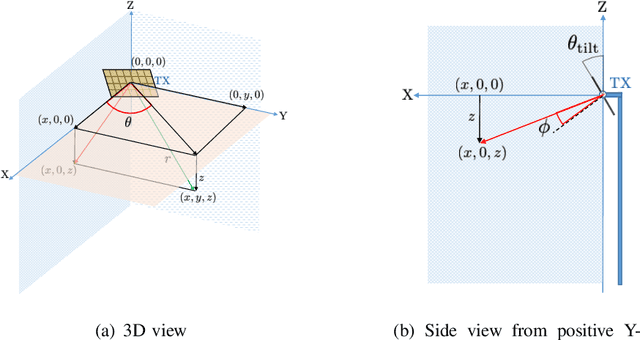

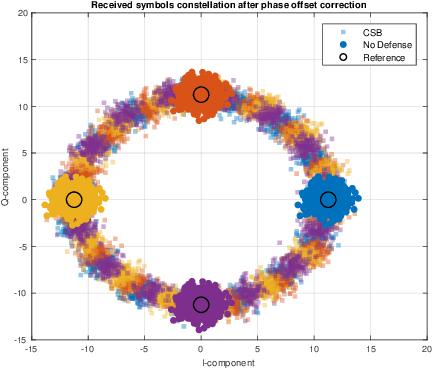

Abstract:Millimeter wave (mmWave) technology can achieve high-speed communication due to the large available spectrum. Furthermore, the use of directional beams in mmWave system provides a natural defense against physical layer security attacks. In practice, however, the beams are imperfect due to mmWave hardware limitations such as the low-resolution of the phase shifters. These imperfections in the beam pattern introduce an energy leakage that can be exploited by an eavesdropper. To defend against such eavesdropping attacks, we propose a directional modulation-based defense technique where the transmitter applies random circulant shifts of a beamformer. We show that the use of random circulant shifts together with appropriate phase adjustment induces artificial phase noise (APN) in the directions different from that of the target receiver. Our method corrupts the phase at the eavesdropper without affecting the communication link of the target receiver. We also experimentally verify the APN induced due to circulant shifts, using channel measurements from a 2-bit mmWave phased array testbed. Using simulations, we study the performance of the proposed defense technique against a greedy eavesdropping strategy in a vehicle-to-infrastructure scenario. The proposed technique achieves better defense than the antenna subset modulation, without compromising on the communication link with the target receiver.
Deep Learning-based Compressive Beam Alignment in mmWave Vehicular Systems
Feb 27, 2021
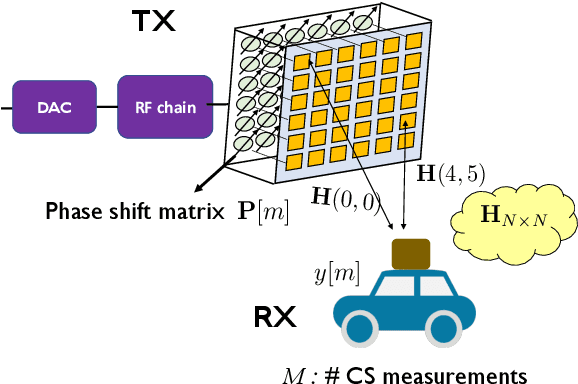
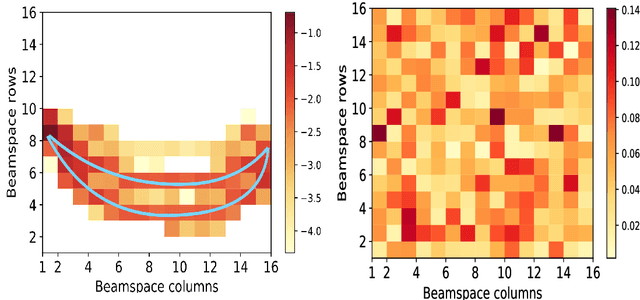
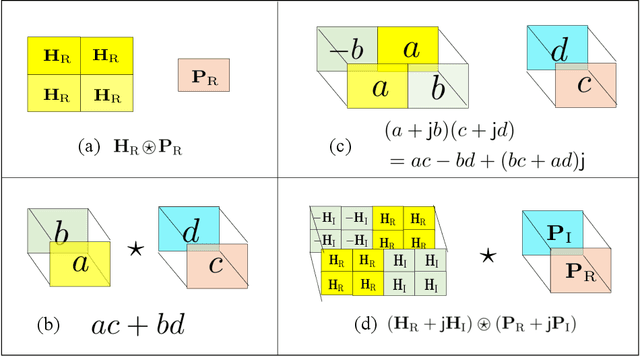
Abstract:Millimeter wave vehicular channels exhibit structure that can be exploited for beam alignment with fewer channel measurements compared to exhaustive beam search. With fixed layouts of roadside buildings and regular vehicular moving trajectory, the dominant path directions of channels will likely be among a subset of beam directions instead of distributing randomly over the whole beamspace. In this paper, we propose a deep learning-based technique to design a structured compressed sensing (CS) matrix that is well suited to the underlying channel distribution for mmWave vehicular beam alignment. The proposed approach leverages both sparsity and the particular spatial structure that appears in vehicular channels. We model the compressive channel acquisition by a two-dimensional (2D) convolutional layer followed by dropout. We design fully-connected layers to optimize channel acquisition and beam alignment. We incorporate the low-resolution phase shifter constraint during neural network training by using projected gradient descent for weight updates. Furthermore, we exploit channel spectral structure to optimize the power allocated for different subcarriers. Simulations indicate that our deep learning-based approach achieves better beam alignment than standard CS techniques which use random phase shift-based design. Numerical experiments also show that one single subcarrier is sufficient to provide necessary information for beam alignment.
 Add to Chrome
Add to Chrome Add to Firefox
Add to Firefox Add to Edge
Add to Edge